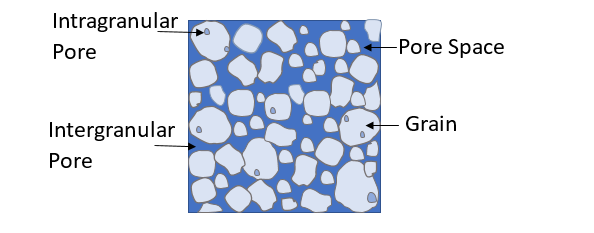
Resource Assessment/Porosity 101
Last week we kicked our 2020 Vision series with a look at data quality. This week, we’ll be looking at the details behind the question:
How much oil and gas is present?
This is a key question driving production rates, stock, capital backing, and oil and gas property transactions. How do we begin to estimate how much oil and gas are in the ground, sometimes several thousands of feet below the surface?
A simplified volumetric equation is:

Care must be taken to use appropriate unit conversions and convert from reservoir to surface conditions if desired.
One of the key parts of the equation is porosity, or how much space is available to hold fluid. Porosity has a huge control on resource calculated and a small change in the porosity calculation can greatly impact the estimate of resource, particularly in low porosity reservoirs. Porosity is defined as the volume of pore space divided by the total volume of the rock, expressed as a percent or a decimal.

Rocks are comprised of tiny grains that have been compacted under high pressures. Grain size, shape, sorting (the distribution of particle size and shape), and packing (the arrangement of grains) impact the size and arrangement of the space available for fluid. Mineralogy impacts porosity because different rocks have different compressibility, strength, and crystal frameworks. Sandstones typically have higher porosity than shales or carbonates. Porosity can be primary (from initial spaces between grains at the time of compaction) or secondary (caused by fracturing or dissolution of grains or cement post-lithification).
Diagenetic history (the process of changing from sediment to sedimentary rock) also greatly impacts porosity. Secondary processes can either enhance or destroy primary porosity. For example, fractures can create porous conduits for flow, or they may be filled with impervious cement. Grains may be dissolved, enhancing porosity, or new minerals may reprecipitate that are tighter packed, causing lower porosity. Pore spaces can contain intergranular fluid that is well connected and moveable, or fluid that is intragranular (voids within individual grains). Microporosity contains fluid bound within clays, that is not moveable. The effective porosity characterizes the porosity which contains moveable fluid and has a positive relationship to permeability, or the ease at which fluid moves through rock.

Most consolidated rocks have porosity less than 40%. Oil and gas production in the conventional space targets high porosity, high permeability rocks. Oil and gas production in the unconventional space targets low porosity and low permeability rocks and often relies on techniques to enhance fluid flow by propping open induced fractures.
Typically, porosity is measured using log tools or by laboratory analysis of core samples.

Thad Toups is the Owner and President of Haas Engineering. Founded in 1980, we’ve been providing reservoir engineering services and consulting for a vast array of companies in the energy space.

Recent Comments